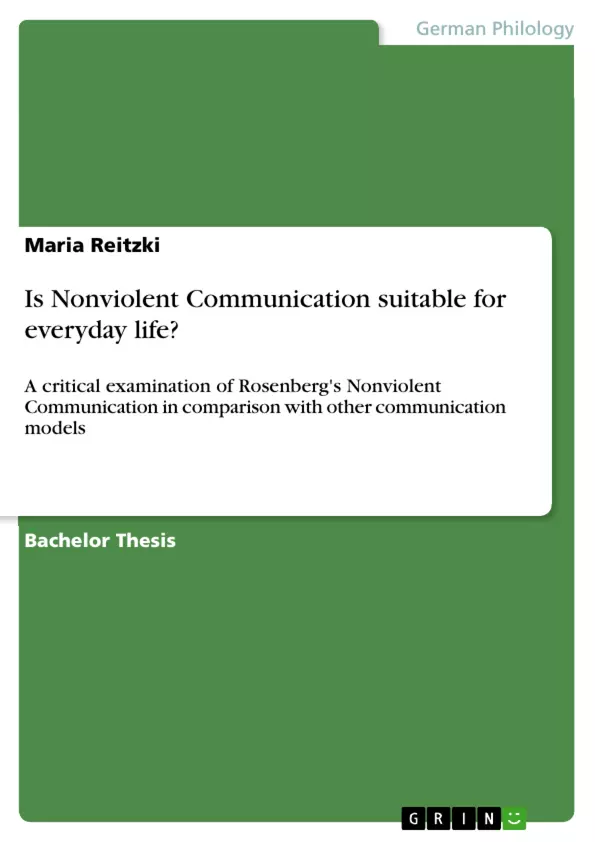
Is Nonviolent Communication suitable for everyday life?
Bachelorarbeit, 2007
43 Seiten, Note: 1,3
Leseprobe
Inhaltsverzeichnis (Table of Contents)
- Introduction.
- Nonviolent Communication according to Rosenberg.........
- The emergence of nonviolent communication..
- The basic model of nonviolent communication.
- The four components ....
- Empathy.......
- The meaning of the emotional vocabulary.
- The meaning of the symbols of wolf and giraffe.
- Influences on the method of nonviolent communication......
- Influencing Nonviolent Communication according to Rosenberg.
- Influencing Nonviolent Communication through other communication models..
- Similarities with Carl Rogers' work.........
- Similarities with Virginia Satir's work..\n
- Similarities with neurolinguistic programming.
- Similarities with the four-sided model by Friedemann Schulz von Thun......
- Interim conclusion........
- Dangers of Nonviolent Communication
- Festinger's theory of dissonance
- Transfer of dissonance theory on nonviolent communication........
- Strategies for dissonance reduction......
- The strategies for Rosenberg's four-component model..\n
- Nonviolent communication and manipulation
- Second interim conclusion.......
- Conclusion.
Zielsetzung und Themenschwerpunkte (Objectives and Key Themes)
The primary objective of this research is to investigate the suitability of nonviolent communication for everyday use, focusing exclusively on the original model developed by Marshall B. Rosenberg. This analysis explores the theoretical foundation of nonviolent communication, its historical development, and its practical applications. By comparing nonviolent communication with other communication models, the work aims to determine its unique features and assess its potential for achieving its stated goal of fostering relationships based on openness and compassion.
- The theoretical basis and origins of nonviolent communication
- Comparison of nonviolent communication with other communication models
- Assessment of the suitability of nonviolent communication for everyday life
- Examination of potential dangers associated with nonviolent communication, including dissonance and manipulation
- Critical evaluation of nonviolent communication, considering both its strengths and weaknesses.
Zusammenfassung der Kapitel (Chapter Summaries)
The initial chapters provide an overview of nonviolent communication, its historical background, and its core components. The author explores the development of the concept through the personal experiences of Dr. Marshall B. Rosenberg, outlining his motivation for promoting nonviolent communication and the core principles guiding its application. This section highlights the four components of nonviolent communication: observations, feelings, needs, and requests. The author also examines the concept of empathy within nonviolent communication and explores the significance of both emotional vocabulary and symbolic representations within the model.
Subsequent chapters analyze the influences on nonviolent communication, drawing comparisons with other prominent communication models. The work examines similarities between nonviolent communication and the theories of Carl Rogers, Virginia Satir, and Friedemann Schulz von Thun, as well as neurolinguistic programming (NLP). This comparative analysis highlights the potential strengths and weaknesses of nonviolent communication in comparison to other established communication methods. The author examines potential dangers associated with nonviolent communication, specifically addressing the theory of cognitive dissonance and its impact on the application of the model. Additionally, the author investigates the potential for manipulation within nonviolent communication, exploring the ethical considerations and implications of such practices.
Schlüsselwörter (Keywords)
The work centers on the concepts of nonviolent communication, conflict resolution, empathy, and communication models. It examines the applicability of nonviolent communication in everyday life, focusing on its potential benefits and drawbacks. The study explores the relationship between nonviolent communication and other prominent communication models, including those of Carl Rogers, Virginia Satir, and Friedemann Schulz von Thun, as well as neurolinguistic programming (NLP). The research also investigates the potential dangers of nonviolent communication, including cognitive dissonance and manipulation, and offers a critical evaluation of its overall effectiveness and suitability for everyday use.
Details
- Titel
- Is Nonviolent Communication suitable for everyday life?
- Untertitel
- A critical examination of Rosenberg's Nonviolent Communication in comparison with other communication models
- Hochschule
- Universität Bielefeld
- Note
- 1,3
- Autor
- Maria Reitzki (Autor:in)
- Erscheinungsjahr
- 2007
- Seiten
- 43
- Katalognummer
- V1170833
- ISBN (eBook)
- 9783346578907
- Sprache
- Englisch
- Schlagworte
- nonviolent communication rosenberg
- Produktsicherheit
- GRIN Publishing GmbH
- Preis (Ebook)
- US$ 20,99
- Arbeit zitieren
- Maria Reitzki (Autor:in), 2007, Is Nonviolent Communication suitable for everyday life?, München, Page::Imprint:: GRINVerlagOHG, https://www.diplomarbeiten24.de/document/1170833
- Autor werden
- Ihre Optionen
- Vertriebskanäle
- Premium Services
- Autorenprofil
- Textarten und Formate
- Services für Verlage, Hochschulen, Unternehmen

- © GRIN Publishing GmbH.
- Alle Inhalte urheberrechtlich geschützt. Kopieren und verbreiten untersagt.
- info@grin.com
- AGB
- Open Publishing
Der GRIN Verlag hat sich seit 1998 auf die Veröffentlichung akademischer eBooks und Bücher spezialisiert. Der GRIN Verlag steht damit als erstes Unternehmen für User Generated Quality Content. Die Verlagsseiten GRIN.com, Hausarbeiten.de und Diplomarbeiten24 bieten für Hochschullehrer, Absolventen und Studenten die ideale Plattform, wissenschaftliche Texte wie Hausarbeiten, Referate, Bachelorarbeiten, Masterarbeiten, Diplomarbeiten, Dissertationen und wissenschaftliche Aufsätze einem breiten Publikum zu präsentieren.
Kostenfreie Veröffentlichung: Hausarbeit, Bachelorarbeit, Diplomarbeit, Dissertation, Masterarbeit, Interpretation oder Referat jetzt veröffentlichen!
- GRIN Verlag GmbH
-
- Nymphenburger Str. 86
- 80636
- Munich, Deutschland
- +49 89-550559-0
- +49 89-550559-10
- info@grin.com
-









